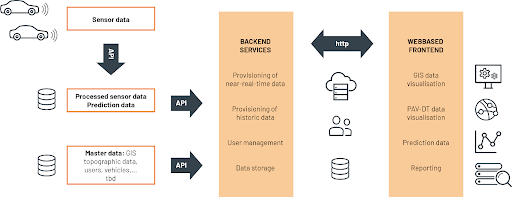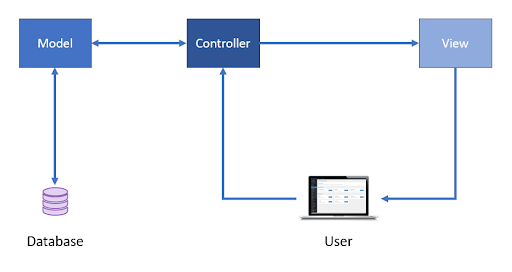
11 May PAV-DT: Architecture and implementation of a web-based solution
The web-based solution for PAV-DT combines the advantages of an API (Application Programming Interface) with state-of-the-art web frameworks. This approach helps to visualise historical and real-time data of road conditions. Programming guidelines such as the MVC (Model-View-Controller) pattern were applied to support the customisation and extension of the web application according to specific use cases.
To ensure usability and accessibility regardless of location and to create the PAV-DT application, a web-based approach was used. To support that approach, several API endpoints were established. They enable data transfer between several hard- and software components. The API first collects the sensor data from driving vehicles. After successfully collecting the data, it will be processed and formatted into human-readable values before being sent to the backend services which are developed by MINDS & SPARKS GmbH. Once the data was processed and prepared in the backend service, it can then be visualised and evaluated on the frontend for the end-user, depending on the required use case.
The backend services are responsible for receiving and providing data such as near-real-time or historic data. Backend services also process and maintain user management and general data. An API provided by the backend service enables safe and secure data transfer to the web-based frontend, where data can be visualised and presented in a comprehensible way and interpreted by the application’s end users. The graphic below provides a brief overview of the architecture.
Implementation and development
For the development process, state-of-the-art web frameworks and libraries were used to ensure flexibility and persistency. The web-based approach allows the end-user to use this software regardless of location and device. In order for the application to be adapted and improved, the MVC pattern was applied. Also, a clear and structured separation of responsibilities within the program code is of utmost importance to ensure performance and maintenance.
The Application
The result is an extendable and customisable web application that can be adapted based on the requirements of the end-user party. Near real-time data as well as historical data visualizations and data report functionalities were implemented, covering a wide range of use cases. The prediction functionality helps to predict how the values of the IRI (International Roughness Index) might change over time, which allows a timely discovery of possible road damage. Sudden and unexpected road maintenance may therefore be prevented.


